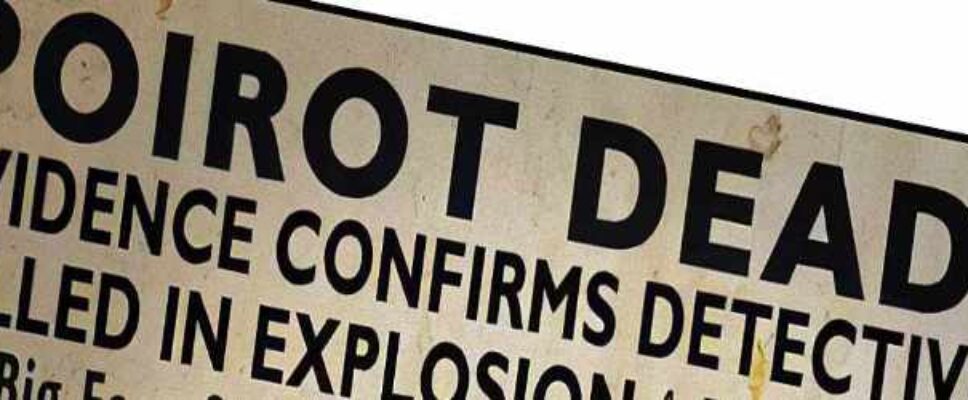Teresa Reviews “The Big Four” (2013)
Teresa Reviews “The Big Four” (2013) and found that scriptwriter Mark Gatiss cobbled together a crackling winner of an episode.
Fidelity to text: 2 bishops
 Mark Gatiss completely rearranged and recast the novel into something where, at best, names and situations match.
Mark Gatiss completely rearranged and recast the novel into something where, at best, names and situations match.
Quality of movie on its own: 4 1/2 bishops
 Mark Gatiss made it a much better movie than it should have been! Cohesive, internally consistent, and reasonably plausible.
Mark Gatiss made it a much better movie than it should have been! Cohesive, internally consistent, and reasonably plausible.
Read more of Teresa’s Agatha Christie movie reviews at Peschel Press.
Also, follow Teresa’s discussion of these movies on her podcast.

They’re a publishing house. You expected better?
Anyway, Campbell Christie, Archie’s brother, found a solution. He suggested that she take a series of Poirot short stories previously published in Sketch magazine in 1924 and string them together into a novel. He helped by revising the beginning and ending of each short story, making them flow together into a more coherent narrative. There were twelve short stories in all.
To my knowledge, they haven’t been republished in their original form. They’re certainly not in Hercule Poirot’s Casebook, which contains fifty stories and claims to be the definitive collection. I’d have remembered reading the death by chessboard or the murder by leg of mutton. So, unless you’ve got the pertinent issues of Sketch handy, reading The Big Four is the only way you’ll read these very early Poirot tales. They’re … gone.
Considering Agatha’s stress levels, she (and Campbell) performed a fairly good Frankenstein surgery, stitching the stories together into something they were never meant to be. The Big Four is a ridiculous, over-the-top, round-the-world thriller involving an evil Chinese mastermind (a la Fu Manchu), a mad French lady scientist, Poirot’s secret twin brother, an American soap millionaire, and a plot to rule the world. It almost reads as a parody of that era’s Bulldog Drummond novels. Bulldog is patriotic, loyal, physically and morally intrepid. He’s got money, brains, and friends. He predates Doc Savage and The Executioner, but has similar, wildly implausible, globe-spanning thrilling adventures.

That’s the novel Mark Gatiss faced. He seized upon names, plots, and scenarios. He rewrote, rearranged, and turned situations topsy-turvy. He addressed the central issue head-on: is it possible, even plausible for a small cabal of evil, international geniuses to take over the world and run it from their evil villain lair in the Swiss Alps?
Could a cabal of egotistical, international evil geniuses even get along long enough to not kill each other within a few hours?
You’re told the answer in one of the earliest scenes, soon after the original gang of four (Japp, Hastings, Miss Lemon, and valet George) assemble for Poirot’s funeral. Intrepid reporter, Tysoe, confronts Ingles, an important man in the foreign service. Tysoe claims he’s got information about The Big Four. They’re causing riots and mayhem all around the world, destabilizing it so they can seize control. Ingles eyes him, recognizes the credulous, tinfoil-hatted idiot he’s dealing with, and dismisses Tysoe’s story as Bulldog Drummond claptrap.
There are other little clues to Gatiss’ intentions scattered throughout. How could an aging, has-been actress be involved with the Big Four? Could Diana Paynter be correct that her husband’s not a secret mastermind, merely a commonplace adulterer? Why would the anonymous, murdered informant be wearing decades-out-of-date formalwear with the remains of a costumer’s label inside? Why would the estranged nephew of the murdered Sinophile have kept a trunkful of theatrical souvenirs? And why would said nephew not show up to collect his inheritance? The Sinophile had a very nice collection of Chinese antiquities stored inside a very nice manor. An heir with sense would have shown up promptly to rake in the loot from the estate sale. Unless that heir had other roles to play.
And so he does.
There is no complicated plot involving criminal masterminds and world domination. The world is busy getting ready to fight another devasting war all on its own. It’s a different kind of lunacy, far more likely and far more local. The Sinophile’s nephew’s the one whose been pulling the strings all along. He’s a master puppeteer, manipulating the gullible Tysoe as well as the hypochondriac Stephen Paynter. He’s in the background in every scene, pushing, urging, coaxing his subjects to do what they want to do anyway.
You don’t have to live in a villain’s lair under the Swiss Alps to make events go your way. You just have to meet enough people who want whatever will help your plans along and then persuade them to follow the dictates of their own hearts.
Is it plausible that a character actor could manipulate the rich and famous? Any conman will tell you yes.
If you’re willing to let yourself go and enjoy the ride, it’s a fun film from start to finish. The opening funeral reunites Hastings, Japp, and a very much missed and sadly underused Miss Lemon. And her cat.

I doubt it. The chess was reasonably accurate, however. Grandmasters and duffers of that era opened with Ruy Lopez. The third move places the white bishop in column b, row 5. Watching that nerve-biting scene reminded me of the Sheep to Shawl contest at the Pennsylvania Farm Show. For us fiber arts fans, watching the sheep being sheared, the fleece carded and spun by a team of spinsters, then dyed and woven into a shawl was riveting. Non-fans like Bill leapt for the exits, desperate for escape. Non-chess fans will understand the emotion.

It all ties together beautifully. I enjoyed it when I didn’t think I would. I didn’t think The Big Four was filmable. I was happily proved wrong.


